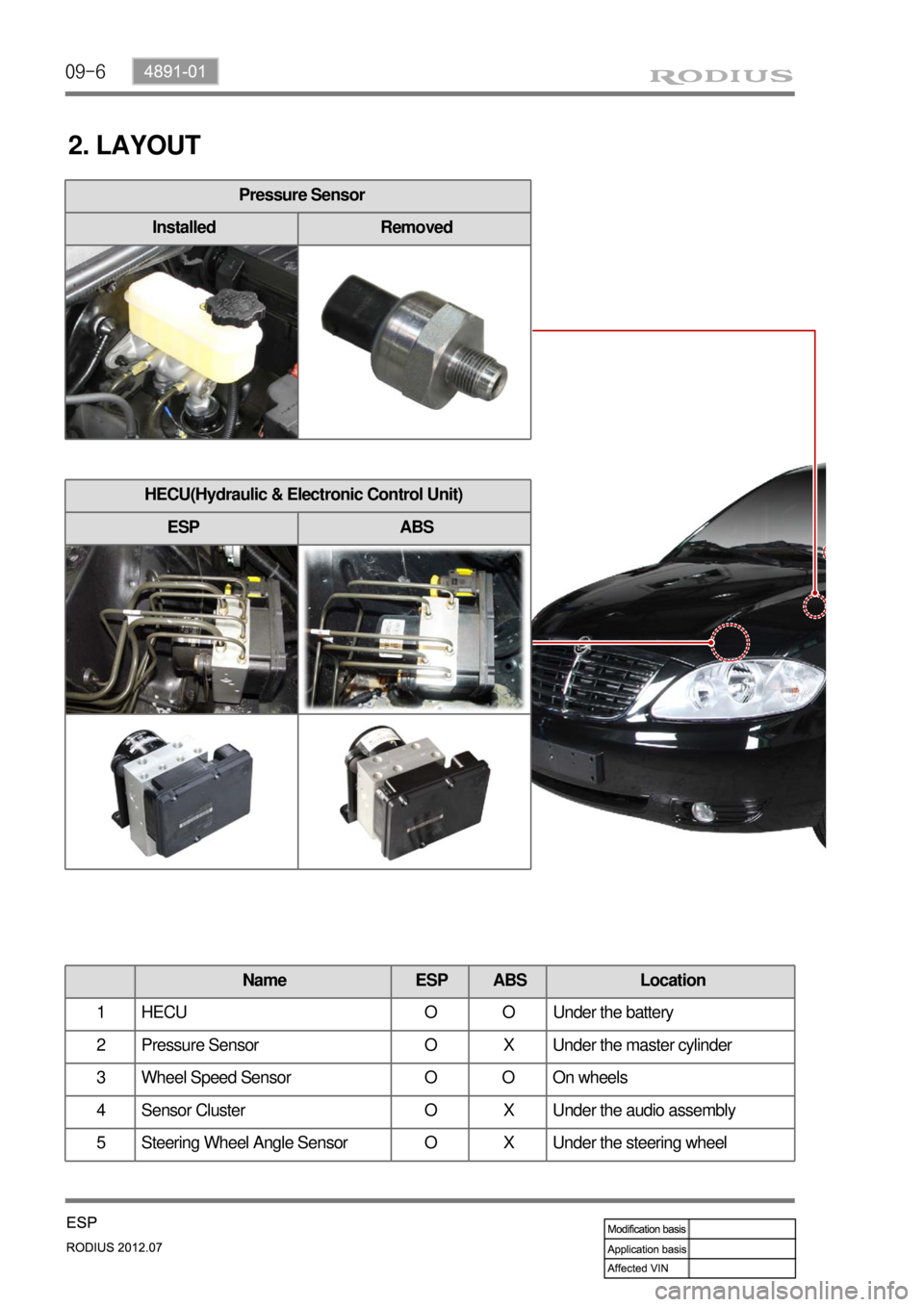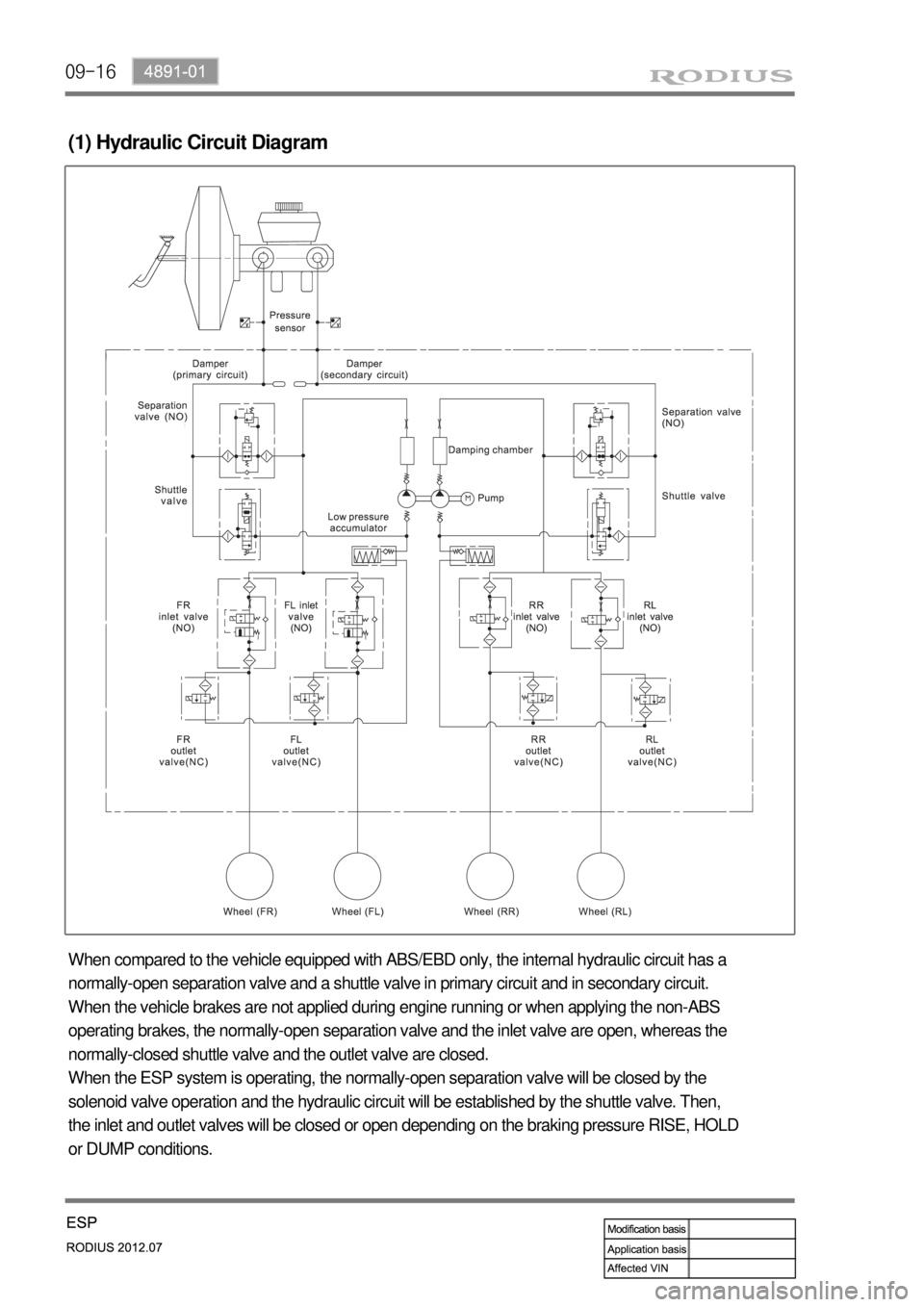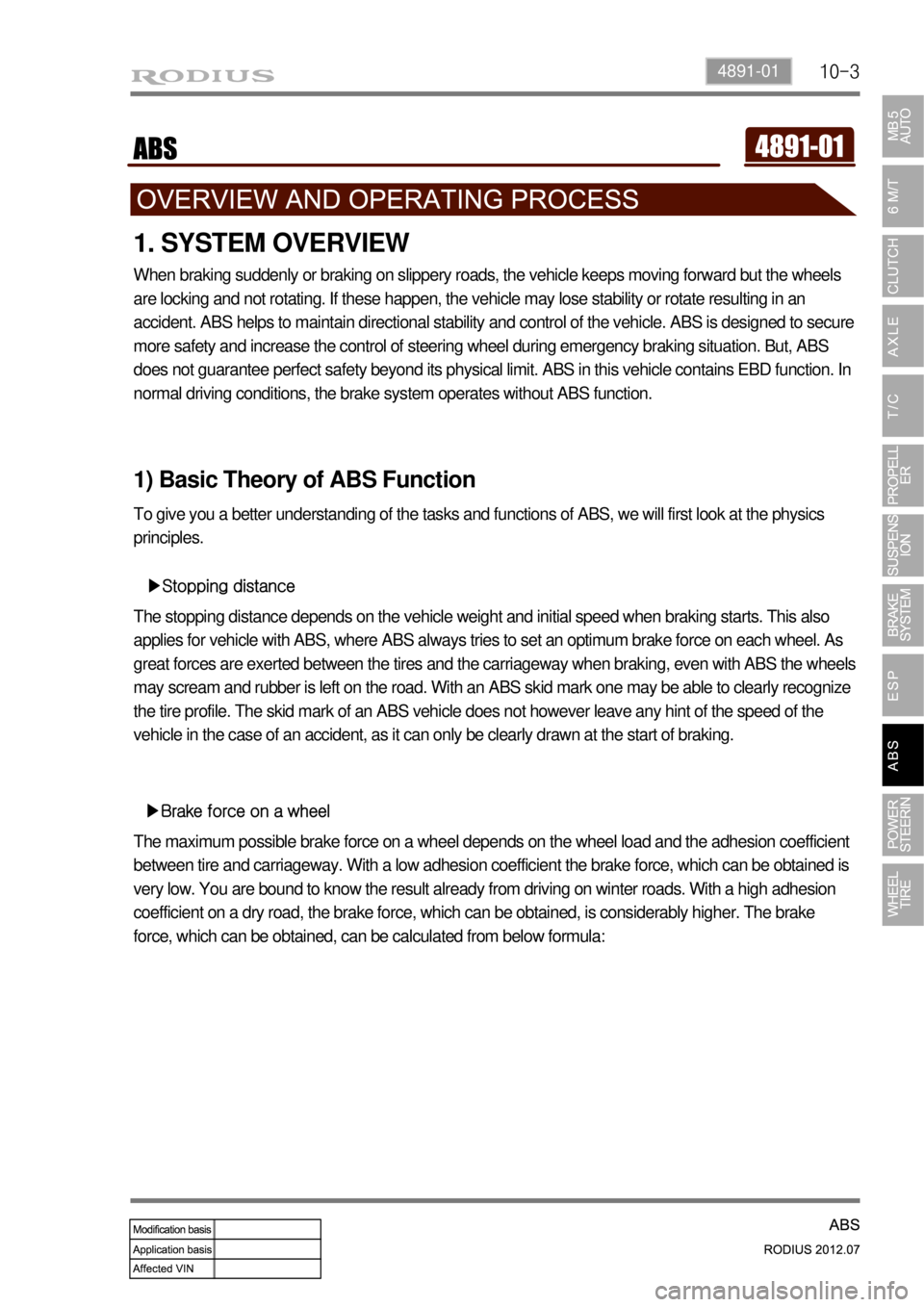ABS SSANGYONG RODIUS 2012 Owner's Manual
[x] Cancel search | Manufacturer: SSANGYONG, Model Year: 2012, Model line: RODIUS, Model: SSANGYONG RODIUS 2012Pages: 715, PDF Size: 79.36 MB
Page 613 of 715

09-54891-01
1. ESP (Electronic Stability Program)
ESP system contains the ABS (Anti-Lock Brake System), ABD (Automatic Braking Differential),
ASR (Acceleration Slip Regulation), Cornering Control and HBA (Hydraulic Brake Assist System)
functions.
â–¶Cornering Control (Understeer and Overersteer) Function
This function controls the vehicle stability by applying the braking pressure on each wheel
according to the yaw rate, lateral sensing value and driver’s steering wheel control.
â–¶HBA (Hydraulic Brake Assist System) Function
HBA (Hydraulic Brake Assist) system helps in an emergency braking situation when the driver
applies the brake fast, but not with sufficient pressure, which leads to dangerously long braking
distance. ECU recognizes the attempt at full braking and transmits the signal calling for full brake
pressure from the hydraulic booster.
Page 614 of 715

09-6
HECU(Hydraulic & Electronic Control Unit)
ESP ABS
2. LAYOUT
Name ESP ABS Location
1 HECU O O Under the battery
2 Pressure Sensor O X Under the master cylinder
3 Wheel Speed Sensor O O On wheels
4 Sensor Cluster O X Under the audio assembly
5 Steering Wheel Angle Sensor O X Under the steering wheel
Pressure Sensor
Installed Removed
Page 620 of 715

09-12
(4) Vehicle Control During Cornering
The figure below shows the vehicle controls by the ESP system under various situations such as
when the brake pedal is depressed or not depressed during cornering, when the ABS is operating
and when braking without the ABS. It also includes the vehicle conditions when the TCS, a part of
the ESP system, is operating.
Condition Understeer control Oversteer control
Only ESP in
operation
No braking by
driver
ESP
+
Normal braking
(no ABS operation)
ESP
+
ABS brake
ESP + ASR
Page 623 of 715

09-154891-01
4. SCHEMATIC DIAGRAM
When equipped with ABS, the braking force at each wheel will be controlled with 3-channel 4-
sensor method. And when equipped with ESP, 4 wheels will be controlled independently with 4-
channel method. (When controlling ABS system only, it will be operated with 3-channel method.)
When compared to the vehicle equipped with ABS/EBD only, the internal hydraulic circuit has a
normally-open separation valve and a shuttle valve in primary circuit and in secondary circuit.
When the vehicle brakes are not applied during engine running or when applying the non-ABS
operating brakes, the normally-open separation valve and the inlet valve are open, whereas the
normally-closed shuttle valve and the outlet valve are closed. When the ESP system is operating,
the normally-open separation valve will be closed by the solenoid valve operation and the hydraulic
circuit will be established by the shuttle valve. Then, the inlet and outlet valves will be
closed or open depending on the braking pressure increase, decrease or unchanged conditions.
â–¶The warning lamp comes on and warning beep sounds when the ESP is operating
Driving feeling when the ESP is operating â–¶
â–¶Noise and vibration that driver senses when the ESP is operating
1) Hydraulic Circuit Diagram
When the ESP operates during vehicle movement, the ESP warning lamp on the instrument
panel flickers and beep comes on every 0.1 seconds. The ESP operation shows that the vehicle
stability is extremely unstable and it is used to warn the driver. The ESP system is just a
supplementary system for the vehicle motion and it cannot control the vehicle when it exceeds
the physical limits. Do not solely rely on the system but be advised to drive the vehicle safely.
When the ESP system activates, the driving feeling can be different depending on vehicle
driving conditions. For example, you will feel differently when the ESP system is activated during
when ABS is operating with the brakes applied and when brakes are not applied on a curve.
Thus, the ESP system would make the driver feel more abruptly when the brakes are applied
during the ESP system activation.
The ESP system may transfer noise and vibration to the driver due to the pressure changes
caused by the motor and valve operations in a very short period of time. Extreme cornering will
trigger the ESP operation and this will make the driver feel noise and vibration due to sudden
brake application. Also, the ESP system controls the engine output. So, the driver may notice
the engine output decrease even when the accelerator pedal is being applied.
Page 624 of 715

09-16
(1) Hydraulic Circuit Diagram
When compared to the vehicle equipped with ABS/EBD only, the internal hydraulic circuit has a
normally-open separation valve and a shuttle valve in primary circuit and in secondary circuit.
When the vehicle brakes are not applied during engine running or when applying the non-ABS
operating brakes, the normally-open separation valve and the inlet valve are open, whereas the
normally-closed shuttle valve and the outlet valve are closed.
When the ESP system is operating, the normally-open separation valve will be closed by the
solenoid valve operation and the hydraulic circuit will be established by the shuttle valve. Then,
the inlet and outlet valves will be closed or open depending on the braking pressure RISE, HOLD
or DUMP conditions.
Page 625 of 715

09-174891-01
(2) Hydraulic Circuit of HBA
The above figure shows one front and one rear wheel and the same hydraulic circuit forms as in
the ESP operation. When HECU recognizes that it is an emergency and it is required for hard
braking, depending on the pressure value of the brake pressure sensor and pressure changes
caused by the pressure sensor timing, it operates the pump immediately to apply the brake
pressure at the wheels. Then, the pressure in the pump increases until just before the
corresponding wheel gets locked. The motor still keeps rotating and the outlet valve and the
separation valve will stay closed. When the wheel starts to lock, the HBA function cancels and
switches to ABS operation.
Page 627 of 715

09-194891-01
â–¶DUMP (ESP is working) Mode
The pressure decreases just before the wheel speed drops and the wheels are locked.
The inlet valve closes and the outlet valve opens as in the ABS HECU and the oil is gathered at
the low pressure chamber while no additional oil is being supplied. Then the pump operates to
allow fast oil drainage. The shuttle valve and the separation valve do not operate while
decompression.
Page 629 of 715

09-214891-01
â–¶RISE (ESP is working) Mode
The shuttle valve and inlet valve will be open and the separation valve and outlet valve will be
closed. Then, the pump is operated. When ESP operates while the ABS is operating, the pressure
will be increased continuously until just before the corresponding wheel gets locked.
Page 630 of 715

09-22
2) Electric Circuit Diagram
Wheel speed sensor, Stop lamp switch, Self diagnostic connector, Warning lamp (ABS/ESP) â–¶
Page 632 of 715

10-34891-01
1. SYSTEM OVERVIEW
When braking suddenly or braking on slippery roads, the vehicle keeps moving forward but the wheels
are locking and not rotating. If these happen, the vehicle may lose stability or rotate resulting in an
accident. ABS helps to maintain directional stability and control of the vehicle. ABS is designed to secure
more safety and increase the control of steering wheel during emergency braking situation. But, ABS
does not guarantee perfect safety beyond its physical limit. ABS in this vehicle contains EBD function. In
normal driving conditions, the brake system operates without ABS function.
1) Basic Theory of ABS Function
To give you a better understanding of the tasks and functions of ABS, we will first look at the physics
principles.
â–¶Stopping distance
The stopping distance depends on the vehicle weight and initial speed when braking starts. This also
applies for vehicle with ABS, where ABS always tries to set an optimum brake force on each wheel. As
great forces are exerted between the tires and the carriageway when braking, even with ABS the wheels
may scream and rubber is left on the road. With an ABS skid mark one may be able to clearly recognize
the tire profile. The skid mark of an ABS vehicle does not however leave any hint of the speed of the
vehicle in the case of an accident, as it can only be clearly drawn at the start of braking.
â–¶Brake force on a wheel
The maximum possible brake force on a wheel depends on the wheel load and the adhesion coefficient
between tire and carriageway. With a low adhesion coefficient the brake force, which can be obtained is
very low. You are bound to know the result already from driving on winter roads. With a high adhesion
coefficient on a dry road, the brake force, which can be obtained, is considerably higher. The brake
force, which can be obtained, can be calculated from below formula: